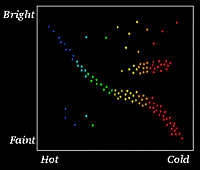 |
||
| First page | ||
 |
||
| Birth | ||
 |
||
| Main Sequence | ||
 |
||
| White Dwarf | ||
 |
||
| Red giant | ||
 |
||
| Supernova | ||
 |
Death | |
 |
||
 |
||
Stellar evolution is very important to astronomers who seek to find out the history of the universe and even though we might not see dramatic changes by watching a single star, we can use the fact that the sky contains many stars in different stages of their life cycle to study the way they evolve.

What we see when we look at the sky on a dark night is a snapshot of the stellar population and we can represent this snapshot by plotting some of the characteristics of stars on the H-R diagram. The H-R diagram is a plot of a star's temperature to its luminosity (i.e. how bright they are). Different stars have different colours, and one can find out its temperature by studying its colour. We can then use the distrubution of stars in the H-R diagram together with stellar models to trace out the evolution of a star.
If you look at the H-R diagram, to the right, you will see that most stars are gathered on a diagonal band. That line is called the Main Sequence and stars remain on the Main Sequence for most of its life. You'll also see that there are some stars at the top right that are brighter than those of the main group with the same temperature, they are the Red Giants. The stars at the bottom left are known as White Dwarfs.
23 August 2000
Sarah Amandusson
www_astro@mssl.ucl.ac.uk